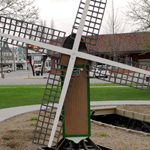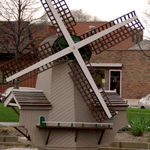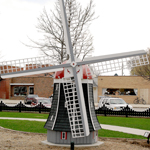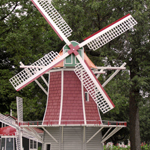Dutch Molens
The six molens on the canal are scale models of historic Dutch molens and represent different time periods in the economic and cultural history of the Netherlands. They were a gift from Rod and Sara Shea of Middleton, Wisconsin.
1. Standard Molen (Post Mill)
 This is the oldest type of molen used as early as 1200 to grind corn.
This is the oldest type of molen used as early as 1200 to grind corn.
2. Wipmolen (Hollow Post Mill)
 Developed during the 15th century, this is the oldest drainage molen. It evolved from the Standard Molen and was used to drain the polders.
Developed during the 15th century, this is the oldest drainage molen. It evolved from the Standard Molen and was used to drain the polders.
3. Paltrokmolen
 Developed around 1600, these were used to saw timber. Logs arriving on flats had to remain in water for a long time before they were sawn, thus this molen was always located along a waterfront.
Developed around 1600, these were used to saw timber. Logs arriving on flats had to remain in water for a long time before they were sawn, thus this molen was always located along a waterfront.
4. Tjasker
 Continuing around on the sidewalk, you will see on your right a small molen called “Tjasker.” These molens were used to keep pasture lands dry and have fallen entirely into disuse. These do not resemble the typical Dutch Molen in any way.
Continuing around on the sidewalk, you will see on your right a small molen called “Tjasker.” These molens were used to keep pasture lands dry and have fallen entirely into disuse. These do not resemble the typical Dutch Molen in any way.
5. Poldermolen
 Developed in North Holland during the 16th century to drain polders, these molens were built in gangs of five, each one lifting the water three feet.
Developed in North Holland during the 16th century to drain polders, these molens were built in gangs of five, each one lifting the water three feet.
6. Stellingmolen (Tower Mill)
 About 1604, Dutch millwrights started to build large and tall molens to grind corn; these were able to catch the wind across other buildings and did not have to be erected on the outskirts of the towns. Used as a corn mill for industrial purposes during the 17th century.
About 1604, Dutch millwrights started to build large and tall molens to grind corn; these were able to catch the wind across other buildings and did not have to be erected on the outskirts of the towns. Used as a corn mill for industrial purposes during the 17th century.
7. Canal
 As you walk across the bridge which spans the canal, note the fares one would pay to cross the bridge. This is a replica of the baluster lifting bridge found in Ouderkerk, Friesland. The mechanism which would open the bridge to canal traffic was a counterbalanced beam so that it could be opened by one person.
As you walk across the bridge which spans the canal, note the fares one would pay to cross the bridge. This is a replica of the baluster lifting bridge found in Ouderkerk, Friesland. The mechanism which would open the bridge to canal traffic was a counterbalanced beam so that it could be opened by one person.
10. Water Pump
 Centered in Windmill Park is a replica of the town pump in Middleburg, Zeeland. This was not only a water source for people, but the place to share the news by the citizens.
Centered in Windmill Park is a replica of the town pump in Middleburg, Zeeland. This was not only a water source for people, but the place to share the news by the citizens.
